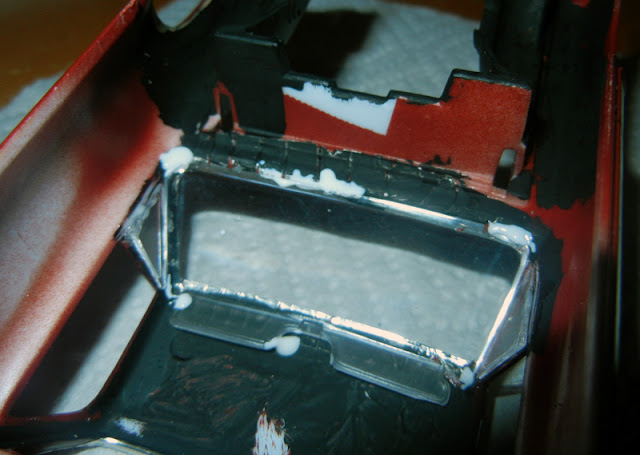You'd think after 10 years of being back in the hobby I could put in a windshield without making a huge mess, but if you do, think again. The glass for the
66 Chevelle needed to go in and I found myself procrastinating. Like
Bare Metal Foil, scale glass can be a pain and if I don't do it, I won't screw it up.
But the damn model won't be done either. So here's my current technique. First, I cut the plastic glass of the sprues and immediately bag it up or wrap it up. I can't tell you how many times I've scratched or damaged the glass before I even attempt to glue it into the model.
Next up using a #11 e-xacto I scrape anywhere I need to add glue. It's been my experience, and you should message me if you think I'm wrong, that NO modelers glue, ANYWHERE will penetrate paint (or chrome, for that matter). So very delicate scraping, like the A pillar here, is in order, and patience as always is the key.
It's not quite glue time. But let's talk glues. Right now my favorite for glass work is Microscale's
Micro Kristal Klear. I have tried (I think) all of them out there--
Testor's glass glue, Testor's stinky red,
watch crystal glue, epoxy, Elmer's. etc. Even CA, which of course you can't use because the fumes turn the clear glass white (learned that one the hard way). In fact when you are working with any plastic glass, anywhere in the room, don't even squeeze a drop of CA out of the tube. The fumes can ruin the glass (as well as you brain!) so stay away!
Thank goodness, it's still almost time to glue, but not quite. Get some
3M clear scotch tape and a dispenser, get some tape, and stick it on and off your pant's leg a few times. You want it to be tacky, but not too tacky.
Here's the trick. Tape the glass into place, make sure it looks OK, then with a toothpick, dab some of the MKK in place. Just a bit. Let it dry, and then remove a piece of tape, then put down some more glue. Repeat until the window is secure (in this case, the quarter pane) and all tape has been removed. Yes, this takes a lot of time, especially when you have a lot of glass to glue in, and yes, you have to be very patient. And yes, if the tape is too sticky you can pull the entire glass out. It takes practice.
The windshield going in after the quarter pane is dry. It's a rare windshield that goes in without a lot of tape, and a fair amount of fear and loathing. Best to just set some glue and then walk away for a few hours.
One of the best things about MKK is that until it is completely dry, which means maybe 24 hours, you can clean it and thin it with
Tamiya X-20A thinner. So if you do make a mess, you can fix things. Of course, if you are applying X20A as a cleaning agent over a surface painted with Acrylic, the acrylic paint might come off as well, exposing the plastic beneath. Bummer. Doesn't model making suck?























































